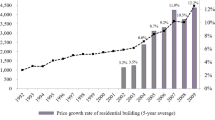Abstract
A new mode of housing tenure in Japan, rental housing with fixed rental terms, was introduced in March 2000 with the revision of the Japanese Tenant Protection Law. This paper examines the implications of this new system by analyzing the determinants of the choices by households among the three types of housing tenure in Japan: owned housing, general rental housing, and rental housing with fixed rental terms, and calculates the estimated compensating variation. Our micro-data is based on the three waves of Japanese household longitudinal data (Keio Household Panel Survey, KHPS) covering all of Japan. The difference between general rental housing and rental housing with fixed rental terms is reflected in the length of the contract term and the level of rent. We carefully eliminate potential sample selection bias introduced to the conditional logit housing tenure choice model through the estimation of the hedonic price regression of each housing tenure alternative. We find that households with a smaller number of family members, those who moved from outside the local housing market, those headed by an unmarried household head, and those with plans to own a house in the near future tend to select rental housing with fixed rental terms. The estimated mean compensating variation by introducing rental housing with fixed rental terms for all households selecting that tenure is 1,205 JPY per month or 1.96% of their monthly rent. Moreover, younger and/or lower income households derived the greatest benefit from the revised law in the form of lower rents.


Similar content being viewed by others
Notes
A similar contract system was introduced to the land market in 1992 when the Land and Housing Lease law was enacted to permit owned housing with a fixed-term lease for the land.
The average floor space of owned housing in 1968 was 85.36 m2, while that of rented housing was 35.46 m2. The corresponding floor space increased to 101.29 and 39.36 m2 in 1978, 112.08 and 43.08 m2 in 1988, and 121.67 and 45.59 m2 in 2003 (Source: Japanese Census of Housing).
Also, see a similar related theoretical study by Seshimo (2003).
See, for example, Abe et al. (1998).
Seko and Sumita (2007) examined this court-arbitrated rent control system on Japanese renters’ mobility.
To make a distinction, rental housing without a fixed rental term is referred to as general rental housing.
See Survey of Housing Market Tendency of 2005 by the Ministry of Land, Infrastructure and Transport.
The KPHS data set was different from their data set. Our data set was more general than theirs because their data was limited to the Tokyo metropolitan area and new contract-basis asking rents. Our data set covered all of Japan and included not only newly contracted rents, but also the lower rents for non-contract rentals. In addition, our rents were market rents, which were actually contracted between landlords and tenants. Their rents were the asking and advertised rents, not the realized and actually contracted ones.
The space within the house can also be used for the scale variable. But this variable includes many missing observations. Therefore, this was not used to ensure as many observations as possible.
However, an anonymous referee suggested that an upward-sloping relationship between rent and the length of time of contract is only one of the possible patterns. Although Sotodate derived the result based on McConnell and Schallheim (1983), Grenadier (1995) showed that there are three patterns: upward-sloping, single-humped, and downward-sloping patterns.
Although the ownership rate decreases after age 40, it may be because the KHPS sample covers only those respondents aged between 20 to 69 as of January 2004.
Cho (1997) analyzed four tenure choices.
An anonymous referee suggested this derivation.
Gu and Colwell (1997) suggest that rent levels are affected by the characteristics of renters.
See Dolton et al. (1989) for the application to labor economics.
We calculated the fitted values of these hedonic models using Duan’s (1983) “smearing” method.
These estimated results are available from the authors upon request.
See Greene (1997), pp. 486–487.
In this test, we calculated the number of observations times R-squared. We obtained R-squared by regressing the squares of residuals on the squares of fitted values. The statistic has χ 2(1) under the null hypothesis of homoskedasticity.
We estimated a regression model with an augmented term of the square value of the fitted values and tested the null hypothesis of the coefficient of the augmented term equal to zero.
It is important to know that the revised JTPL does not permit the conversion of general rental housing into fixed-term contracts while existing tenants reside in the dwelling.
References
Abe, Y., Nomura, Y., & Hukui, H. (1998). Rental housing with a fixed rental term. Tokyo: Shinzan Book Company (in Japanese).
Boehm, T., Herzog, H., & Scholottmann, A. (1991). Intra-urban mobility, migration, and tenure choice. Review of Economics and Statistics, 73(1), 59–68.
Bőrsch-Supan, A., Heiss, F., & Seko, M. (2001). Housing demand in Germany and Japan: Paper in Memoriam of Stephen Mayo. Journal of Housing Economics, 10, 229–252.
Bourguignon, F., Fournier, M., & Burgand, M. (2004). Selection bias corrections based on the multinomial logit model: Monte-Carlo comparisons. DELTA Working Paper No. 2004-20.
Brownstone, D., & Englund, P. (1991). The demand for housing in Sweden: Equilibrium choice of tenure and type of dwelling. Journal of Urban Economics, 29, 267–281.
Cho, C. J. (1997). Joint choice of tenure and dwelling type: A multinomial logit analysis for the city of Chongju. Urban Studies, 34, 1459–1473.
Dolton, P. J., Makepeace, G. H., & Van der Klaauw, W. (1989). Occupational choice and earnings determination: The role of sample selection and non-pecuniary factors. Oxford Economic Papers, 41, 573–594.
Duan, N. (1983) Smearing estimate: A nonparametric retransformation method. Journal of the American Statistical Association, 78(383), 605–610.
Edin, P. A., & Englund, P. (1991). Moving cost and housing demand: Are recent movers really in equilibrium? Journal of Public Economics, 44, 299–320.
Goodman, A. C., & Kawai, M. (1982). Permanent income, hedonic prices, and demand for housing: New evidence. Journal of Urban Economics, 12, 214–237.
Grenadier, S. R. (1995) Valuing lease contracts: A real-option approach. Journal of Urban Economics, 38, 297–331.
Greene, W. (1997). Econometric analysis (3rd ed.). Upper Saddle River, NJ: Prentice Hall.
Gu, Y. A., & Colwell, P. F. (1997). Housing rent and occupational rank in Beijing and Shenyang, People’s Republic of China. Journal of Property Research, 14, 133–143.
Hausman, J., & McFadden, D. (1984). Specification tests for the multinomial logit model. Econometrica, 52(2), 1219–1240.
Horioka, C. (1988) Tenure choice and housing demand in Japan. Journal of Urban Economics, 24, 289–309.
Horioka, C., & Watanabe, W. (1997). Why do people save? A micro-analysis of motives for household saving in Japan. Economic Journal, 107, 537–552.
Iwata, S. (2002). The Japanese Tenant Protection Law and asymmetric information on tenure length. Journal of Housing Economics, 11, 125–151.
Jarque, C. M., & Bera, A. K. (1987). A test for normality of observations and regression residuals. International Statistical Review, 55, 163–172.
Koenker, R. (1981). A note on studentizing a test for heteroscedasticity. Journal of Econometrics, 17, 107–112.
Lee, L. F. (1983). Generalized econometric models with selectivity. Econometrica, 51(2), 507–512.
Lee, L. F., & Trost, R. P. (1978). Estimation of some limited dependent variable models with application to housing demand. Journal of Econometrics, 8, 357–382.
McConnell, J. J., & Schallheim, J. S. (1983). Valuation of asset leasing contracts. Journal of Financial Economics, 12, 237–261.
McFadden, D. (1974). Conditional logit analysis of qualitative choice behavior. In P. Zarembka (Ed.), Frontiers in econometrics, Chapter 4 (pp. 105–142). New York: Academic.
Moriizumi, Y. (2003). Targeted saving by renters for housing purchase in Japan. Journal of Urban Economics, 53, 494–509.
Ohtake, F., Yamaga, H. (2001a). The impact of the terminal tenancy system on the private rental housing rent. (in Japanese) Japanese Economic Studies, 42, 1–20.
Ohtake, F., & Yamaga, H. (2001b) The terminal tenancy system and the private rental housing rent. (in Japanese) The Quarterly Journal of Housing and Land Economics, 41, 10–19.
Ramsey, J. B. (1969). Tests for specification errors in classical linear least-squares regression analysis. Journal of the Royal Statistical Society, Series B, 2, 350–371.
Seko, M., & Sumita, K. (2007) Effects of government policies on residential mobility in Japan: Income tax deduction system and the rental act. Journal of Housing Economics 16(2), 167–188.
Seshimo, H. (2003) Optimal tenant protection. Regional Science and Urban Economics, 33(1), 59–92.
Sotodate, M. (1997). Contract with fixed rental term and the option value of the contract renewal right. (in Japanese) Japanese Economic Studies, 35, 45–68.
Train, K. E. (1998). Recreation demand models with taste differences over people. Land Economics, 74(2), 230–239.
Train, K. E. (2003). Discrete choice methods with simulation. Cambridge, UK: Cambridge University Press.
White, H. (1980). A Heteroskedasticity-consistent covariance matrix estimator and a direct test for heteroskedasticity. Econometrica, 48(4), 817–838.
Acknowledgments
We presented previous versions of this paper at the 2005 Applied Regional Conference at Meikai University, the Urban Economics Workshop of Tokyo University, and the 2006 HKU-NUS Symposium on Real Estate Research at the University of Hong Kong. The authors would like to thank the participants of those meetings for their valuable comments, especially those of Abdullah Yavas, Shinichiro Iwata, John Quigley, and an anonymous referee.
Author information
Authors and Affiliations
Corresponding author
Appendices
Appendix A
Derivation of Eq. 6
From 4 and 5, the full maximization problem is:
The first order conditions were:
which (locally) gave \(c^{*}_{{jk}} {\left( {Y_{i} ,r^{*}_{{j1}} , \ldots ,r^{*}_{{jK}} ,S_{i} } \right)}\) and the (local) conditional indirect utility function \(U{\left( {Y_{i} ,r^{*}_{{j1}} , \ldots ,r^{*}_{{jK}} ,S_{i} } \right)} = {\mathop V\limits^ \approx }{\left( {Y_{i} ,c^{*}_{j} ,S_{i} } \right)}\).
Appendix B
Estimation results of permanent income model
Appendix C
Estimation results of the reduced form multinomial logit model
Rights and permissions
About this article
Cite this article
Seko, M., Sumita, K. Japanese Housing Tenure Choice and Welfare Implications after the Revision of the Tenant Protection Law. J Real Estate Finan Econ 35, 357–383 (2007). https://doi.org/10.1007/s11146-007-9040-z
Published:
Issue Date:
DOI: https://doi.org/10.1007/s11146-007-9040-z
Keywords
- Housing tenure choice
- Rental housing
- Rent control
- Japan and deregulation
- Conditional logit
- Sample selection bias
- Compensating variation




